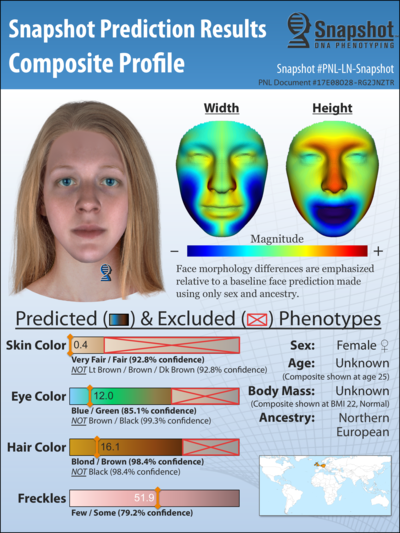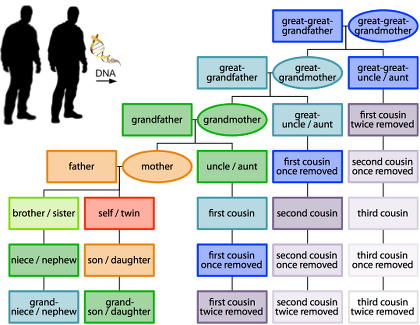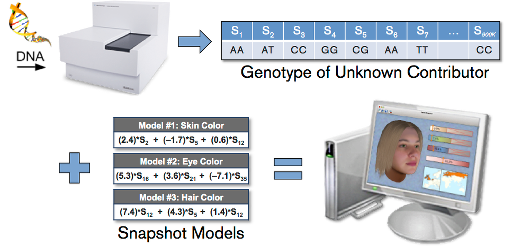The Parabon® Snapshot® Forensic DNA Analysis Service takes advantage of modern SNP technology, translating select biomarkers from a DNA sample into predictions about various physical traits of its source. Using these predictions, Snapshot generates a descriptive profile that contains sex, ancestry, pigmentation (skin color, hair color, eye color, freckling), and even face morphology, as well as excluded phenotypes. Request a sample report.
In addition, the Snapshot kinship capability can be used to identify familial relationship between two DNA samples as distant as third cousins, great-great-great-great-grandparents, or anywhere in between.
The Snapshot DNA Phenotyping Service
When CODIS fails to find a match... Send us a human DNA sample and we will produce a forensic profile containing predictions about the physical traits of its source, which can be used to generate new investigative leads.

An example Snapshot report that combines several trait predictions into a unified "digital mugshot".
Because some traits are partially determined by environmental factors and not DNA alone, Snapshot trait predictions are presented with a corresponding measure of confidence, which reflects the degree to which such factors influence each particular trait. Traits, such as eye color, that are highly heritable (i.e., are not greatly affected by environmental factors) are predicted with higher accuracy and confidence than those that have lower heritability.
Snapshot Extended Kinship Analysis
Parabon Snapshot can also provide inferences about the familial relationship between the sources of two or more DNA samples.
Using the power of genome-wide SNP data, it is possible to precisely calculate the degree of relationship between two people. Whereas traditional STR-based kinship analysis is limited to distinguishing parent/offspring relationships, Snapshot's kinship model uses hundreds of thousands of SNPs to identify up to 6th-degree relationships.


Built with machine learning, the Snapshot kinship model can distinguish up to 6th-degree relatives from unrelated pairs.
How Snapshot Works
Recent advances in DNA sequencing technology have made it practical and affordable to read genetic content from DNA, which in turn has allowed the creation of datasets that include both genotypic (genetic content) and phenotypic (trait) data for each of thousands of subjects. With the diligent and repeated application of data mining and machine learning processes to such data, Parabon NanoLabs produces statistical models that translate the presence of specific genetic biomarkers into forensically relevant trait predictions.

By mining genomic data from large populations of known subjects, Snapshot produces statistical models that identify regions strongly associated with certain forensic traits. It then uses those models to predict the physical appearance of unknown individuals.
Beginning with large datasets comprised of a phenotype (trait) of interest and genotype data for thousands of subjects, our bioinformatics team performs large-scale statistical analysis on millions of individual SNPs and billions of combinations thereof to identify sets of these genetic markers that associate with the given trait. This mining process can take weeks running on hundreds, sometimes thousands, of computers. In the end, those SNPs with the greatest likelihood of contributing to the variation observed in the target trait are culled for potential use in predictive models.
The modeling phase further refines this set of SNPs to a final set that most accurately predict the target trait under a framework of machine learning algorithms. Models are validated against data held out for such testing and calibrated with all available data before being installed into the Snapshot architecture.
Tested on thousands of out-of-sample genotypes, Snapshot's trait predictions have been shown to be highly accurate. For example, Snapshot predicts pigmentation traits with an average accuracy of greater than 80%, and its ability to discriminate between pigmentation extremes is considerably higher.
Even in cases where it is difficult to distinguish between two similar phenotypes — e.g., hazel eyes vs. green — Snapshot can, with high confidence, exclude certain traits (for instance, Snapshot can predict that a subject does not have brown or black eyes with a confidence approaching 100%).
Snapshot Applicability and Uses
Snapshot was built for the defense, security, justice, and intelligence communities. The technology has been validated with as little as five-hundredths of one nanogram (0.05ng) of DNA, generating high-quality genotypes of nearly 1 million SNPs. Snapshot can be applied to any case where DNA has been found that does not match a known suspect or CODIS. Snapshot provides a means to determine the physical appearance and other characteristics of the individuals that are the source of such samples.
The Snapshot kinship capability can be used to establish familial relationships between a DNA sample and previously collected DNA samples or among a set of new samples. Knowledge of these relationships can be used to validate claims of distant kinship, establish relationships within groups of interest, or identify remains when close relatives are not available, such as cold cases, mass disasters, or casualties of past conflicts.
Instead of being stymied by DNA evidence that fails to produce a database match, investigators can now use Snapshot to generate viable leads in cases that might otherwise go cold.
For ordering information, please email snapshot@parabon-nanolabs.com or call (703) 689-9689 x251



